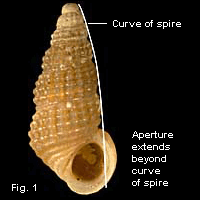|
< Previous family introduction |
|
|||||||
 |
Family Rissoidae Rissoids
|
|||||||
|
The Rissoidae is a family of small or minute molluscs that are abundant in the intertidal zone in many parts of the world, but also occur, although less commonly, on the continental shelf and slope. They occur in all seas and from the Arctic and Antarctic to the tropics, but are particularly common in the Mediterranean and the north-eastern Atlantic. In Australia they are well represented in both tropical and temperate waters. In shell form and habitat they are variable, making recognition as belonging to the family impossible on shell characters alone. Rissoids are epifunal molluscs i.e. they live on the substrate, rather than in it. They are found on algae and in sheltered positions under stones or coral, and in crevices. Those that live on algae feed on diatoms or micro-algae living on their macroalgal host, and are generally highly mobile. Those that live in sheltered positions generally feed on foraminiferans, and are less mobile. The deepwater species are probably detritus feeders. There are 36 species of the family recorded from NSW, the diversity of these following the diversity found in the family worldwide. In shell form the local species range from minute globose shells under 2 mm in length, to elongate shells of over 20 mm that resemble terebrids. In habitat they vary from common intertidal species such as Alvania novarensis to deep water species such as Pusillina profundior which is known from 450-1650 m deep. Of the 36 species here recognised as occurring in NSW, 35 are described as endemic to Australia, the one remaining species being of tropical Indo-West Pacific distribution. Further investigation will probably show that more of these species range outside Australia. Of the 35 Australian species, a few are known only from NSW, most are restricted to eastern Australia, and a few occur in eastern and southern Australia. In other families it is common for species to occur over a range of southern Queensland to south-western Western Australia, and this will probably be found to be so with some rissoids when more material is worked up. In NSW the family was first treated by Laseron (1950), who provided minimal figures and descriptions of 94 species. He worked only from shell morphology of specimens obtained from beach washup and his own shallow water dredgings. His grouping of the 94 species included species which are now distributed to a wide variety of families, both closely related to and well removed from the Rissoidae as recognised today. Ponder's (1985) world-wide revision of the genera of the family provided a classification based on animal and shell structure, and included detailed treatment of some of the NSW species, as examples of the genera. He also provided a list of temperate Australian species, with synonyms, without treating them in detail. In addition, his work on sorting the Australian Museum collection to species to facilitate his generic revision identified the local species fairly clearly. Following Ponder, Willie Sleurs (1992) wrote a lengthy PhD thesis (that has not been published) treating in detail the species of Rissoina. At the time of writing, Francesco Criscione is working on a revision of the genus Merelina. Family References These are key references for identification of shells in this family. Other references referred to in the text are listed in References, accessible from the Table of Contents page. Laseron, C.F. 1950. Review of the Rissoidae of New South Wales. Records of the Australian Museum 22: 257-287. Ponder, W.F. 1985. A review of the genera of the Rissoidae (Mollusca: Mesogastropoda: Rissoacea). Records of the Australian Museum Supplement 4: 1-221. Coverage All species of the family known to occur in NSW are detailed here. Identification Notes As mentioned above, shell size and shape is variable throughout the Rissoidae. Within the NSW species, shell shape varies from globose to tall and slender, and sculpture varies from almost absent to strong spiral and axial elements. Colour is generally white, but some species are uniformly brown and a few are brown and white banded. There are three shell features that in combination give a useful, but not infallible, indication that shells belong to the Rissoidae. The first is aperture shape; there are no pronounced anterior or posterior canals, but most species have a weak channel at the forward edge of the aperture, and some have a weak posterior channel, usually only a broad, shallow depression in the outer lip. The second character is expansion of the last whorl, beyond the curve of the spire outline (Fig. 1), a character particularly obvious in the genus Rissoina. The third character is a varix on the outer lip of the aperture, varying from weak to very strong.
|
